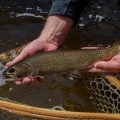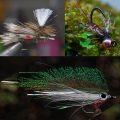How to Tie a Water Walker Variation
Producer: Tim Flagler
This is a variation of Will Dornan’s popular Water Walker fly. I’ve definitely cut some corners as compared to the original but the fly still works remarkably well, particularly in this red and black color combination.
The fly starts with a size 8 Dai-Riki #710 hook, but anything that’s 3X long in the size 6-10 range will work just fine. Begin by getting the hook firmly secured in the jaws of your tying vise.
For thread, I’ve loaded a bobbin with a spool of black UTC 140 Denier. The thread’s extra thickness and strength definitely helps when securing foam to a hook. Get the thread started on the hook shank leaving an eye-length space behind the eye and, after taking a few wraps rearward, snip off the excess tag.
Snip 8-10 red Krystal Flash fibers free from the hank and make sure their ends are snipped off completely square. Give your bobbin a counterclockwise spin as you place the flash on top of the hook shank above your tying thread. Bind the material to the top of the shank, all the way back to the start of the bend.
I like to use plunger-style hackle pliers to get hold of the flash before snipping it off to leave a tail about a hook gap in length. The hackle pliers safely hold the unused flash on my tying bench so it’s ready for the next Water Walker. Take open spiral wraps with your tying thread up the hook shank to the initial tie-in point.
Red micro-sized Ultra chenille is used for the body of the fly and to help keep the foam locked into place. Snip a 4-card-width length free and get hold of it by one end. Place the end on top of the hook shank above your tying thread and, just like the flash, secure it all the way back to the start of the bend. Wrap forward and back again to make sure the chenille is anchored exceptionally well.
Get hold of the chenille and make two complete touching wraps with it behind your tying thread then secure it with tight thread wraps. Pull the chenille back and out of the way on top of your vise or place it in a materials clip.
I like to use a set of River Road Creations’ Beavertail foam cutters to cut out all the foam for this fly. I’m going to use just the small and medium-sized cutters with this size 8 hook. Using the small cutter, cut out the lower foam layer for the Water Walker from a sheet of red 2 mm craft foam. If there is one, snip the excess little nubbin off close.
Super glue, here, Fly Tyer’s Z-ment is your friend with anything foam. Place a small drop on top of the hook shank, above your tying thread, then align the front edge of the foam cut-out with the back edge of the hook eye. Secure it to the top of the shank with 3 or 4 tight wraps of tying thread. Make sure the foam sits directly on top of the hook shank.
Using the medium-sized cutter, produce a foam body from a sheet of black 2 mm craft foam and snip the nubbin off it as well. Apply a small drop of super glue to the red craft foam at the tie-in location. Align the front edge of the black foam with the front edge of the red foam, then secure it with 3 or 4 tight turns of tying thread.
Get hold of the chenille and take two wraps with it at the tie-down location, pulling tightly as you go to further compress the foam. Pull the foam back and continue taking wraps around the hook shank with the chenille, behind your tying thread. When you reach the position on the shank beneath the small indentation on the foam, anchor the chenille with tight wraps of tying thread. Then, as before, pull the chenille back and out of the way. Reach for the super glue once again and place a small drop above your tying thread. Use your thread to lock the red foam down, right at it’s forward indentation. Place another drop of super glue at the tie-down location then anchor the black foam. The fly should now look something like this.
For the fly’s underwing, snip 8-10 strands of pearl Krystal Flash free from the hank and make sure the ends are trimmed off square. Place those ends on top of the foam, above your tying thread, and take wraps to secure them. Once again, use hackle pliers to secure the material, but this time, trim the flash off so it extends just proud of the foam body. Again, store the flash in a safe place for the next fly.
I’m going to use one layer of tan 1 mm craft foam for the fly’s overwing, but two layers of .5 mm craft foam are more traditional. Whichever you choose, cut the wing or wings out using the medium-sized foam cutter. Here, too, ditch the nubbin.
Pick up another small amount of super glue and place it on top of the fly at the location of your tying thread. Align the rear tip of the tan foam with the rear tip of the black foam, and lay it on top of the fly, like so. Take nice tight wraps to secure it. Then, push the forward-pointing portion of the tan foam back and take a few more thread wraps in front of it.
Small, black round rubber legs are used to form the legs of the fly. Here’s where I really take some shortcuts. Leaving two strands together, pull them free from the rest. Fold the two strands in half then locate the midpoint. With the loop forward, anchor the midpoint of the strands with two wraps of tying thread to the top of the fly. Then work the strands down to either side and secure them further.
To make the fly more visible on the water’s surface, snip a card-width segment of white Polypropylene floating yarn free from the card. Place the segment’s midpoint on top of the fly and anchor it with tight wraps of tying thread. You could use super glue here too, if you’d like.
Again, reach for your plunger-style hackle pliers but this time get hold of the chenille. Take two wraps with it to cover up the thread wraps below then pull tight. Pull everything back and take wraps with the chenille behind your tying thread, up to the hook eye. Secure the chenille with a few tight thread wraps then let go with your hackle pliers and lift the front of the fly up so it sits at a 45 degree angle in your tying vise. This will help prevent subsequent thread wraps from slipping off the eye under the weight of your bobbin.
Reach in with the very tips of your tying scissors and snip the small amount of excess chenille off close. Get hold of your whip finish tool and use it to do a 5 or 6 turn whip finish behind the hook eye. Here, too, having the fly angled up really helps. Seat the knot well and snip or cut your tying thread free. Get the fly oriented back to its normal position in the jaws of your tying vise.
Pull the white yarn up and snip it off fairly short. It should still be nice and visible. Next, snip the front loop of the rubber legs. Split the legs into individual strands then trim them off to about a hook shank in length. Head cement applied to the thread wraps behind the hook eye, and to where the rubber legs meet the body, will help to increase the fly’s durability.
And that’s the way I like to tie a Water Walker. I’m able to tie them a little faster using this method and they seem no less effective. Water Walkers float well enough to hold a fairly large dropper, making for an exceptionally deadly combination.
How to Tie a Walt's Worm
How to Tie a WD-40











